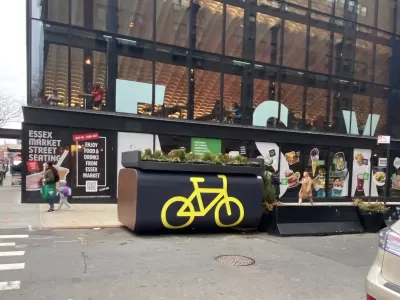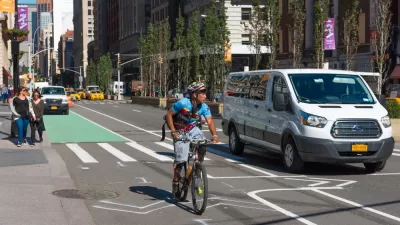While the city waits to evaluate data, advocates argue that recent demonstration projects have already proven the popularity of secure bike parking.

After six months of a successful secure bike parking program in a partnership with Oonee at locations around New York City, bike advocates are wondering what the holdup is.
According to a statement from the city’s Department of Transportation, “DOT stands by its commitment in the Streets Plan to continue exploring secure bike parking, and looks forward to reviewing the data from the Oonee demonstration.” Yet, according to an article by Gersh Kuntzman for Streetsblog NYC, “There’s already ample data on Oonee’s efficacy” in previous pilot programs.
The recent program, Kuntzman argues, will likely not show similarly robust results simply because “By the time locals figured out what the device was and how to use it, it was gone.” Anecdotally, people who used the secure parking expressed enthusiastic support for the service. “The need, and the public demand, for secure bike parking has long been documented, most recently in a Transportation Alternatives report that documented that a lack of safe places for bike parking not only reduces cycling, but reduces safety, increases theft (particularly to working cyclists) and hurts local businesses.”
A network of secure bike parking could also encourage more people to replace car trips with bike trips and lower their carbon footprint. “Earlier this year, a study on climate change mitigation by Cornell University’s School of Industrial and Labor Relations recommended the conversion of 5 percent of street parking spaces into 150,000 sheltered bike parking spaces by 2025.”
FULL STORY: After Successful Bike Parking Demo, DOT is Rightfully Being Asked, ‘What Now?’

Alabama: Trump Terminates Settlements for Black Communities Harmed By Raw Sewage
Trump deemed the landmark civil rights agreement “illegal DEI and environmental justice policy.”

Planetizen Federal Action Tracker
A weekly monitor of how Trump’s orders and actions are impacting planners and planning in America.

Why Should We Subsidize Public Transportation?
Many public transit agencies face financial stress due to rising costs, declining fare revenue, and declining subsidies. Transit advocates must provide a strong business case for increasing public transit funding.

Understanding Road Diets
An explainer from Momentum highlights the advantages of reducing vehicle lanes in favor of more bike, transit, and pedestrian infrastructure.

New California Law Regulates Warehouse Pollution
A new law tightens building and emissions regulations for large distribution warehouses to mitigate air pollution and traffic in surrounding communities.

Phoenix Announces Opening Date for Light Rail Extension
The South Central extension will connect South Phoenix to downtown and other major hubs starting on June 7.
Urban Design for Planners 1: Software Tools
This six-course series explores essential urban design concepts using open source software and equips planners with the tools they need to participate fully in the urban design process.
Planning for Universal Design
Learn the tools for implementing Universal Design in planning regulations.
Caltrans
Smith Gee Studio
Institute for Housing and Urban Development Studies (IHS)
City of Grandview
Harvard GSD Executive Education
Toledo-Lucas County Plan Commissions
Salt Lake City
NYU Wagner Graduate School of Public Service





























